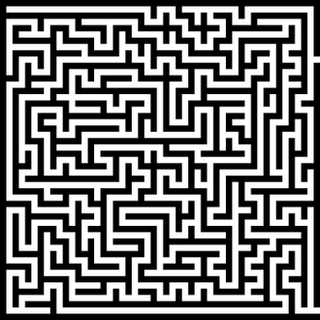Well that was fun! Complete with ASCII art output I present ...
█ ██████ █████████████████████ █
█ █ █ █
█ █ █ █
█ █ ██████████████████████████ █
█ █
█ █
██████ ██████ ███████████ ██████
█ █ █ █ █ █
█ █ █ █ █ █
███████████████████████████████ ██████
█ █
█ █
██████ █████████████████████ ██████
█ █ █
█ █ █
██████ ███████████ ███████████ █
█ █ █ █
█ █ █ █
█████████████████████ ██████ ██████
█ █ █ █
█ █ █ █
███████████████████████████████ ██████
█ █
█ █
private struct Cell
{
public bool visited;
public bool right;
public bool top;
}
static void Main(string[] args)
{
Random Rand = new Random();
int size = 8;
var maze = new Cell[size,size];
for (int x = 0; x < size; x++)
for (int y = 0; y < size; y++)
{
maze[x, y] = new Cell() { right = true, top = true, visited = false };
}
int count = size * size;
int positionX = Rand.Next(size);
// mark space below (outside matrix)
for (int y = 0; y < size; y++)
{
maze[positionX, y].top = false; maze[positionX, y].visited = true;
count--;
// move left or right n spaces
int n = Rand.Next(size); // random left or right by an amount n
int direction = (Rand.Next(2) == 0) ? 1 : -1;
while (positionX + direction > 0 && positionX + direction < size -1 && n-- > 0)
{
// moving sideways
if (direction == -1)
{
positionX += direction;
maze[positionX, y].right = false;
maze[positionX, y].visited = true;
count--;
}
else
{
maze[positionX, y].right=false;
positionX += direction;
maze[positionX, y].visited = true;
count--;
}
}
}
// Now pick a random place we have visited and extend into new territory
while (count > 0)
{
int x = Rand.Next(size);
int y = Rand.Next(size);
if (!maze[x, y].visited) continue; // not visited yet
// We are on a visited node, where can we go from here?
// Pick a direction to break down a wall - favor left right
if (Rand.Next(4) > 0)
{
if (Rand.Next(2) == 1 && x < size-1 && !maze[x+1,y].visited )
{ maze[x,y].right = false; maze[x+1,y].visited = true; count--;}
else if (x > 0 && !maze[x-1,y].visited)
{maze[x-1,y].right = false; maze[x-1,y].visited = true; count--;}
}
else
{
if (Rand.Next(2) == 1 && y < size - 1 && !maze[x, y + 1].visited)
{ maze[x, y].top = false; maze[x, y+1].visited = true; count--; }
else if (y > 0 && !maze[x, y-1].visited)
{ maze[x, y-1].top = false; maze[x,y-1].visited = true; count--; }
}
}
// Dump the maze
for (int y = 0; y < size; y++)
{
Console.Write("█");
for (int x = 0; x < size; x++)
Console.Write((maze[x, y].top) ? "█████" : " █");
Console.WriteLine();
for (int repeat = 0; repeat < 2; repeat++)
{
Console.Write("█");
for (int x = 0; x < size; x++)
{
Console.Write(maze[x, y].right ? " █" : " ");
}
Console.WriteLine();
}
}


